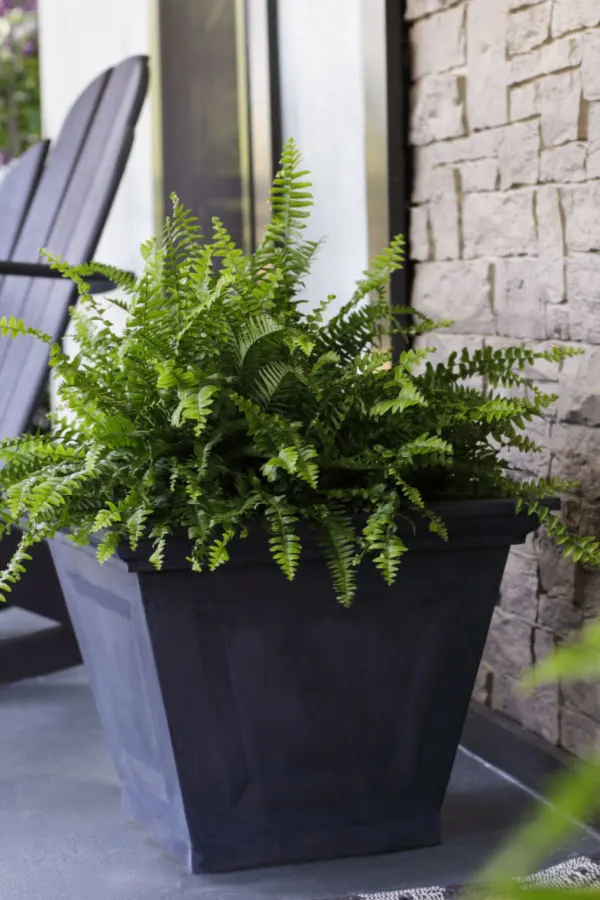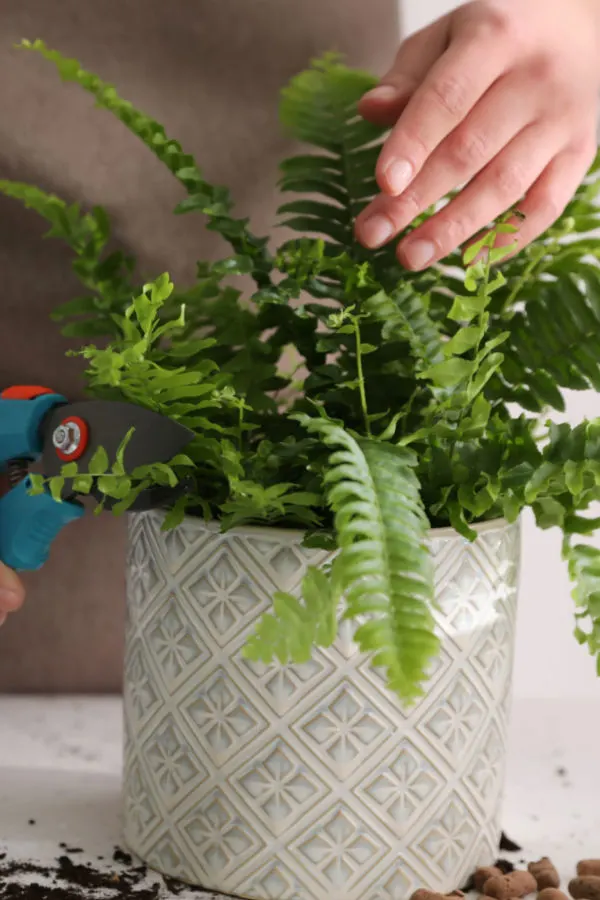Looking for a few winter fern care tips to keep last year’s outdoor ferns alive and well indoors this winter? We have you covered with today’s article!
Saving your potted or hanging ferns from year to year is one of the best ways to save on your gardening budget. Ferns are actually a fairly low maintenance plant, whether growing outdoors in the spring, summer and fall months – or overwintering inside through the cold of winter.
For many though, it’s the indoor winter months that are the most challenging. By the middle of winter, depending on how and where your ferns is overwintering, they can begin to look pretty ragged. In fact, so ragged that many gardeners often mistake their plants for being dead or near death!

Here’s the good news, your plants are more than likely fine. And depending on how and where you are overwintering them, they could be going dormant (which is more than okay), or simply struggling a bit to keep their foliage with low light, too much or not enough water, inconsistent heat – or a combination of all 3!
With that said, here is a look at how to care for your ferns in the middle of the winter, along with a few tricks to have them ready to grow big as spring arrives!
How To Keep Ferns Alive Indoors In The Winter
When it comes to saving your outdoor ferns through the winter months, there are really two options. The first is to continue to grow your fern as a traditional houseplant. As you will see below, this works well for those who have manageable sized ferns, and who have the ideal room and light to keep the plant growing well.
The second option, and by far the easiest of all, is to simple allow your fern to go dormant over the winter. This option can be done right from the start in early fall, or even during the winter if the fern you are trying to grow as a houseplant is starting to look quite shabby.
We will take a look at both options, starting with growing your fern as a houseplant through the winter. Although this one can be a bit trickier, if you have the right conditions and light, it can make for a beautiful houseplant!

Overwintering Ferns As A Houseplant – How To Keep Ferns Alive Indoors
If you are lucky enough to have the right lighting and temperature conditions indoors, you can keep your fern growing right on through the winter months. Ferns do not have to go through a dormancy period. In fact, in their natural habitat, this perennial plant keeps its foliage year round.
So what does it take to keep a fern growing beautifully indoors? Well, for starters, it is best to select smaller ferns to grow as a houseplant.
Large, overgrown ferns are simply too hard to keep in tip top condition through winter. Not only are their roots often bound too tightly for water and nutrients to be absorbed, larger plants struggle to get enough light to keep all of the fronds healthy and green.
If you have a large fern, your best bet is to opt to allow it to go dormant. But if your fern is on the smaller size, bringing it in to grow as a houseplant is quite easy. All it really takes is giving it the right lighting and temperature, and controlling the humidity and moisture it receives.
Keeping Fern Indoors In The Winter As A Houseplant
For best results, move your fern indoors to a room that receives filtered light. Ferns are a shade and moisture loving plant. Unfortunately, placing them near a sunny window or in a room that receives direct sunlight will cause them to dry out. As a result, their fronds will shrivel and die off – just as they would in direct sunlight when outdoors.

Place your fern away from a window in a room that receives only dappled or indirect sunlight. In addition, keep it away and out of the line of heating or cooling vents. These too can dry the plant out in quick fashion.
Watering Your Ferns For Success – How To Keep Your Ferns Alive Indoors
Watering is another big key to success. Ferns can easily rot out if their roots remain too wet. However, they can also suffer if they have no access to moisture as well.
Water plants only when the moisture down in the soil just slightly begins to dry out. Inexpensive moisture meters are great for checking moisture levels deep at the root level.
In addition, sit your plant on a tray or saucer with small pebbles or marbles underneath. This will allow drainage and keep the plant’s roots from sitting in water for too long. Finally, and this is a big key to success, spritz or mist your plants often with water!
By simply misting your plants with water from a water bottle a few times each week, the fronds can absorb the moisture. It keeps the plant hydrated, helping it to stay healthy and green without having to overwater the soil below.

Throughout the winter, do not be afraid trim off fronds that begin to show signs of wear and tear. This will keep your plant looking great. It also allows for new growth to takes its place. As spring returns, your plants can go outside in top condition, ready for another outdoor growing season!
Here’s the good news, if at any time your plant just isn’t cutting it as a houseplant, you can always cut it back and allow it to go dormant until spring. And if your plant is too large, you can also divide it in the spring to create smaller starts with ease. See: How To Divide Ferns
Allowing Ferns To Go Dormant – How To Keep Ferns Alive Indoors
If you simply want to keep your fern alive over winter but don’t want the fuss of houseplant care, you can allow the plant to go dormant. Not only is the process easy, it also helps to eliminate the mess of cleaning up fronds throughout the winter.
To begin, start by cutting back all of the fronds to within a few inches of the soil line. Yes, it will make the plant appear to be quite dead, but no worries, it will overwinter just fine and come back alive in the spring.
Select an area of your home where the temperature remains cool but not too cold. Basements are usually the best spot of all, as they stay both cool and a bit moist. If you have an insulated garage that does not see freezing temperatures, that will work as well.
Winter Lighting – How To Keep Your Ferns Alive Indoors
The good news is that light is not a factor for ferns when they are dormant. They do not require light to stay alive, so even if your basement is dark, it will work. They can be placed in partial light, but it is simply not necessary. The only thing to avoid is placing them where they will receive direct sunlight as it can keep them from going dormant.

Here is the easy part – other than lightly watering your plant a few times each month – that’s all you have to do for dormant winter fern care! As it begins to warm in late winter / early spring, you can move your plant if you wish to a warmer room with dappled light.
This will help the plant begin to come out of dormancy. You may even see new growth appear within a few weeks. As the temperatures begin to warm outdoors, you can then take the plant outside. This will allow it to begin its full growth and fill out once again.
Here is to keeping your ferns alive and well with a little winter fern care. And even more, to saving on plant purchases next spring! If you would like to learn how to keep geraniums alive over winter to grow again next spring, be sure to check out our article How To Save Potted Geraniums Indoors – 2 Easy Ways To Keep Geraniums Alive Over Winter!
Follow Our Facebook Page For Great Gardening Tips And Advice! This Is My Garden Facebook Page
This Is My Garden is a garden website created by gardeners, for gardeners. Jim and Mary Competti have been writing gardening, DIY and recipe articles and books and speaking for over 15 years from their 46 acre Ohio farm. They publish three articles every week, 52 weeks a year. Sign up today to follow via email, or follow along!
